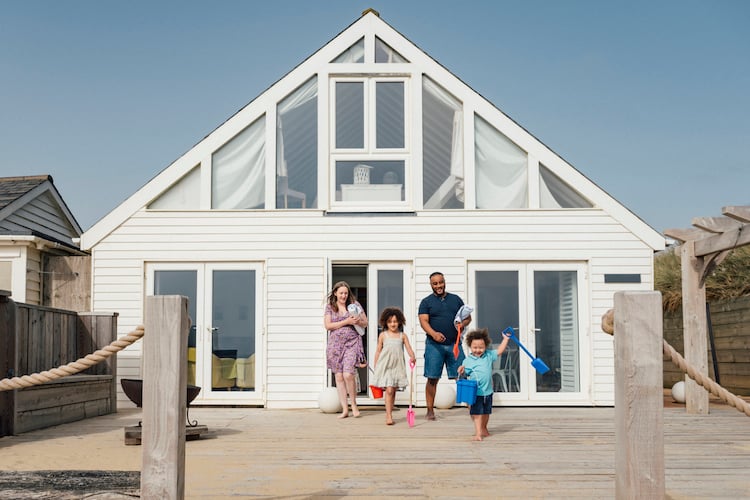Ever since many pandemic travel restrictions were lifted, the short-term rental (STR) real estate market has been on a tear. According to the STR data research firm AirDNA, revenue from STRs listed full time hit an all-time high last year, and guest demand for STR real estate is projected to grow by more than 14%.
If you’ve been thinking about getting into the business, now just might be the perfect time. In this article, we’ll take a closer look at how STR real estate works, important things to know before investing in STR property, and where to find STR real estate in some of the best markets today.
Key takeaways
- STR is generally rented for less than 31 days to the same tenant.
- Advantages to owning STR real estate often include higher annual gross rental incomes and more flexible use of the property because guests only stay for a few days at a time.
- Although STRs have higher operating expenses, annual returns from STR real estate can be the same or more compared to a property rented in the long term.
What is STR real estate?
STR real estate is generally defined as property that is rented for fewer than 31 days to the same tenant.
Examples of STR real estate include:
- Vacation rental homes listed full time, such as an Airbnb business
- Second homes that are rented out part of the time
- A spare bedroom rented out of a primary residence, known as house hacking
STR vs. LTR real estate investing
Long-term rentals (LTRs) and STRs are the most common ways to directly invest in real estate, and both have distinct advantages and disadvantages. Here are some of the similarities and differences between owning and operating STRs vs. LTRs.
Income stream
The rental income from an LTR is generally more predictable because tenants normally lease for 12 months at a time. If a home rents for $1,000 per month, a landlord can reasonably expect to receive $12,000 in gross annual income, unless there is a problem with the tenant. Knowing what the income stream is likely to be makes it easier to budget for expenses, anticipate cash flow, and qualify for financing.
On the other hand, the income stream from STR real estate can be inconsistent and affected by factors such as the average daily rate (ADR), the average stay of each guest booking, competition from nearby resorts and hotels, and seasonality.
However, the gross income stream from STR real estate also can be greater. According to AirDNA, an STR analytics provider, the average annual revenue earned by STRs listed full time reached a record level of $56,000 in 2021.
Tenant turnover
Renters of STR properties frequently come and go, with an average length of stay (ALOS) of between 6 and 7 nights per booking. In order to generate a consistent income stream, an STR property owner needs to constantly be marketing the property for the next guest booking.
By comparison, a landlord with an LTR can normally expect a tenant to turn over no faster than every 12 months, and even longer if the tenant renews their lease for another year.
Operating expenses
STRs and LTRs have similar expenses, such as property management and leasing, property taxes and insurance, homeowner association (HOA) fees, and a mortgage payment if the property is financed. In most cases, utilities in an LTR are paid directly by the tenant or included in the monthly rent if a multifamily property has a master meter for a utility such as water or gas.
But there are additional operating expenses to plan for with STR real estate. Because tenants turn over more often, the maintenance and repair costs will be higher due to more frequent repairs and cleaning. An STR landlord also is responsible for keeping a home fully furnished and decorated, replacing towels and linens as they wear out, restocking kitchen and bathroom supplies, and directly paying for all utilities.
So, even though the gross rental income from STR real estate can be significantly higher than an LTR, the total cost of owning and operating an STR is much greater.
However, even though operating costs are higher with an STR property, potential returns can be the same or greater compared to LTRs. For example, some of the homes listed for sale on the Roofstock STR Marketplace offer potential gross yields comparable to LTR properties.
Financing options
Lenders like predictability, which is one reason loan terms for STRs are different from LTRs.
Because a property rented out to a long-term tenant has consistent income, operating expenses and the mortgage can usually be paid using the incoming cash flow. Traditional financing options for an LTR generally offer competitive interest rates and require a down payment of about 25% of the property purchase price.
When it comes to financing STR real estate, traditional or conventional loans can sometimes be difficult to obtain due to restrictive lending requirements. According to the How to Finance Your Vacation Rental post on the AirDNA blog, types of STR loans available include:
- Asset-based loans evaluated based on the actual or potential income from an STR, rather than a borrower’s income and debt-to-income (DTI) ratio
- Home equity lines of credit (HELOCs) that access accrued equity in a primary residence to use toward the purchase of an STR
- Cash-out refinance of a primary residence or another investment property to raise funds to purchase an STR
Exit strategies
An investor who wants to sell an LTR with a tenant in place is limited to selling to another LTR investor, unless the tenant can be convinced to leave. To be sure, selling a home with a tenant in place isn’t a drawback.
As the Arbor Q4 2021 Single-Family Rental Investment Trends Report notes, cap rates for SFRs dipped to 5.5%, hitting an all-time low. Declining cap rates, also known as “cap rate compression,” occur when property prices increase relative to the stream of net operating income generated. In other words, investors are willing to pay more for less income.
However, an investor with STR real estate can have the best of all worlds by choosing the most profitable exit strategy when the time comes to sell.
Because an STR property isn’t tied up with a tenant on a long-term lease, an owner can more quickly respond to changing market conditions by selling the home to an investor looking for an STR, an LTR, or to an owner-occupant looking for a primary residence.

How to invest in STR real estate
Buying an STR may be a good opportunity for both individual real estate investors and group investing. Here are the general steps to follow and things to consider when purchasing STR real estate:
1. Determine the reason for investing
Some investors buy an STR to add to an existing rental property portfolio, while others are just getting started. A buyer may decide to only look in certain markets or may compare all markets to decide what works best for them.
2. Research the local regulations
Regulations on STR real estate vary from place to place. Some cities that thrive on tourism, such as Kissimmee, FL, and Galveston, TX, are STR-friendly, while other locations actively discourage homes being rented for less than 30 days at a time. An STR investor often will be required to obtain a business license and collect a lodging or rental tax to be remitted to the local municipality.
3. Locate the best STR real estate markets
The best short-term rental markets typically have a high demand from leisure or business travelers—and sometimes a combination of both. However, many also can be located within a day’s drive or less of a major metro area.
According to research from Realtor.com, the 10 best places to buy an STR include Joshua Tree, CA; Sedona, AZ; and St. George, UT. In great STR markets like these, it takes 16 days or fewer for an STR to generate enough income to cover the monthly mortgage payment.
4. Create a budget and financial projections
Resources for finding real-time data on STR real estate include Airbtics, AirDNA, and the Roofstock STR Marketplace to find STRs currently listed for sale.
Key metrics used to measure the financial performance include:
- ALOS
- ADR
- Revenue per available room (RevPAR)
- Occupancy
- Average rent per year
- Cash flow
- Cap rate
- Annualized return
While STRs have similar operating expenses as LTRs, investors should be sure to budget for ongoing costs that are unique to STR real estate:
- Initial cost of furnishing and outfitting an STR and replacing items that are beginning to show wear and tear
- Utilities such as electricity, internet and cable TV, water, and gas
- Supplies for the kitchen and baths, such as toiletries, towels and linens, cooking items, and condiments
- Booking fees paid to short-term listing sites, such as Vrbo or Airbnb
- Cost of cleaning an STR and making repairs in between guest bookings
5. Arrange financing
The process for getting a mortgage for STR real estate is similar to buying an LTR property. The down payment required for an STR may be 30% or more of the purchase price, with interest rates typically 1% higher than the loan for a primary residence.
A lender will ask for documents, including a completed loan application, income and debt documentation, and a credit report. Borrowers generally must have a credit score of 680 or higher, a DTI ratio of between 28% and 36%, and enough cash in reserve to pay for up to 6 months of operating expenses and mortgage payments.
6. Make an offer
Making an offer on an STR property is done the same way as an offer for an LTR. A written purchase and sale agreement is generally used to make an offer on an STR and includes basic terms and conditions, including:
- Property address and legal description
- Purchase price and whether the property is being financed or paid for in cash
- Earnest money amount
- Contingencies such as a property inspection, review of historical financial performance (if the property is already used as an STR), and a financing contingency
- Specific date of closing escrow
- Date and time a seller has to accept the offer
7. Close on the transaction
Once an offer has been accepted and escrow has been opened, a buyer begins due diligence by performing an inspection and removing any contingencies one by one. The lender will begin the loan underwriting process, and the transaction may close in 30 days or fewer.
Closing is normally handled by a title company or real estate attorney, depending on the laws of the state the STR is located in. A buyer takes possession of the property the day of closing and can start collecting rental income the same day.









